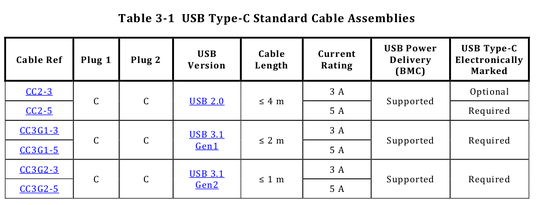The answer is a definite maybe. I'll explain.
USB Type-C is a special beast. It's a "smart" cable, with requirements beyond a standard USB cable. The specifications do not provide for a power-only cable, so the answer is really to the questions of how long can a compliant Type-C cable be, and can you have a longer non-compliant cable?
Standard USB 3.0 Cable
All of the wires in the cable are sized for the task they need to perform. The spec doesn't define a maximum cable length, it defines electrical requirements that must be met. One stated objective in the spec is that the cable be flexible. A range of wire sizes is suggested for each type of conductor in the cable, along with a recommendation that the smallest wire be used that will meet the electrical requirements for the cable length.
The "maximum" cable length is based on the allowable losses using the largest suggested wire sizes. The USB 3.0 spec doesn't preclude making a longer cable as long as it can meet the electrical requirements. This can get expensive if the cable needs to carry signals as well as power.
USB Type-C
Unfortunately, you can't make a Type-C power-only cable out of lamp cord.
The current is spread over multiple contacts.
USB Type-C is a "smart" cable. It has an embedded chip and a configuration line.
The concept envisions the cable as carrying signals so devices can be daisy-chained, and the Type-C spec includes the data lines. A cable would not be considered compliant if it lacked data lines, although a manufacturer might be permitted to make a special-purpose cable just for charging their own device (although the cable could not carry the Type-C logo).
So any Type-C cable longer than the limit shown in that chart would be an expensive, custom cable.
Safety Standards
The 100W capability uses 20V at 5A. These levels have safety concerns, and the cable needs to meet some international safety standards. I have not been able to nail down the specifics of whether there is an approved configuration that limits the length, or like the USB 3.0 spec, there are requirements that can be met with longer cables.
Bottom Line
Probably the easiest way to get a definitive answer is to try to buy one. If you can find a longer cable from a reputable manufacturer, that will answer the theoretical question. The practical answer, though, is that even if you can find one, you probably would not consider it cost-effective.
